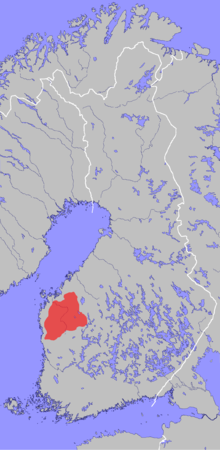South Ostrobothnian dialect
The South Ostrobothnian dialect ( Finnish. Eteläpohjalainen murre ) is a dialect of the Finnish language . It is one of the Western Finnish dialects.
The distribution area of the South Ostrobothnian dialect is largely congruent with the landscape of Southern Ostrobothnia . Only in the east of South Ostrobothnia is a strip in which the Savo dialects are spoken separates the South Ostrobothnian from the Central and Northern Ostrobothnian dialects . In the west, the dialect's distribution area borders on the Swedish-speaking coastal strip. The border is also quite clear compared to the Häme dialects in the south. The language spoken in southern Ostrobothnia is so uniform that it is possible to speak of a single dialect instead of a dialect group.
Linguistic features
The differences between the South Ostrobothnian dialects and the standard Finnish language are mainly phonological . The main features that characterize the South Ostrobothnian dialects are:
- The most important isogloss between Western and Eastern Finnish dialects is the equivalent of written d . In the South Ostrobothnian dialect, this sound has been replaced by an r ( teherä instead of tehdä "to make").
- Written ts corresponds to tt , which is not subject to the level change ( mettä - mettän instead of metsä - metsän "the forest - the forest").
- In contrast to the written language , the intervowel h has been preserved in the unstressed position ( rikkahus instead of rikkaus “wealth”). The original first vowel disappears when it is identical to the second vowel ( tuphan instead of tupaan "in the room").
- Connections of l , h and n with another consonant are resolved by inserting a vowel ( ilima instead of ilma "air").
- After a short stressed syllable, a short vowel becomes long ( isoon taloon instead of ison talon "of the great house").
- Diphthongs with i as the second component become long vowels in unstressed syllables ( punaans instead of punaines “red”).
- Written language tv corresponds partly to rv , partly to lv ( larva or lalava instead of latva “treetop”).
- At the end of the word and syllable, s before the voiced consonant becomes h ( kirkah vesi instead of kirkas vesi "clear water").
- In contrast to the written language, a group of nouns ends in -s ( venes instead of vene "boat").
- The Inessive usually has the suffix -s ( taloos instead talossa "in house"), shows but with pronouns and in conjunction with possessive the peculiar ending -hna / -hnä ( mihinä instead Missä "where", päähnäni instead päässäni "in my head").
- Verbs with a stem ending in -e change the ending from -ee to -oo or -öö ( tuloo instead of tulee "he comes") in the third person singular .
- The first and second person plural have different personal endings in the present and past tense ( saamma - saima instead of saamme - saimme "we get - we got").
literature
- Martti Rapola: Johdatus Suomen murteisiin . 2nd Edition. Helsinki: Suomalaisen Kirjallisuuden Seura, 1961.
